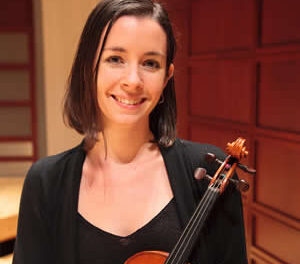Over the years I have become more discriminating about which concerts I choose to attend. Having heard good professional performances of basic repertory works, I don’t feel compelled to attend unpolished amateur presentations. I can be lured out, however, when important or rarely-programmed works are scheduled. Before last Tuesday, I had heard the Raleigh Civic Symphony only once – in August 1985, when then-Curtis Institute student Nicholas Kitchen played the Beethoven Violin Concerto with the town-and-gown orchestra. Because of the very uneven level of playing on that occasion, I had avoided them ever since. Recent glowing comments from colleagues about the group’s progress and even more about the musicianship of their current music director led me to reconsider. The programming of an important work by one of my favorite late-20th century composers was decisive.
On November 27, I joined an audience that filled about 40% of Stewart Theater for what turned out to be a very enjoyable concert. The Raleigh Civic Symphony is now much larger than the orchestra I had endured in 1985. The low strings, with four double basses, a dozen cellos and six violas, were much fuller. The larger violin section had twenty players. The strongest section proved to be the woodwinds. The brass proved to be more reliable than one might have feared. It was worth a trip to see the unusually precise and clear conducting style of Music Director Randolph Foy. He was also responsible for the very extensive and readable program notes. Good notes like these have proven hard to find of late.
A fine performance of Beethoven’s Egmont Overture opened the concert. This was a welcome relief from the over-scheduling of Leonore III locally. The slow introduction was well managed with a steady sarabande rhythm. All the woodwinds, and especially the oboe and clarinet, were excellent. The horns were stronger and steadier than expected and the big horn statement just before the “victory symphony” was very effective.
In addition to referring the audience to his excellent notes, Foy offered remarks and had the orchestra play selections that helped prepare for the challenging second work on the program, Witold Lutoslawski’s twenty minute long Novelette (1978/79). He explained the composer’s style of free atonal harmony and his use of limited aleatorism. He demonstrated both conventionally-beaten time as well as the sections with limited aleatoric time where players have notes to play but are free rhythmically. Because of this, every performance has some unique portions. Foy said that this was the most aesthetically challenging work that the orchestra had ever attempted. Novelette has five movements, four short ones (Announcement, First Event, Second Event and Third Event) and a much longer and more developed Conclusion. After opening with a driving rhythm for full orchestra, the first movement quickly changed to high quiet atonal swoops for the strings.
Concertmistress Dana Friedli had a prominent solo as did the piccolo player who piped bird-like chirrupings. The buzzing strings that opened the First Event were quickly joined by flutes and clarinets. Sassy brass notes were added by trombones and horns, along with percussion. and delicious low bassoon notes brought this section to an end. Comic bits for solo English horn, clarinet and bassoon were featured in the Second Event. The Third Event brought buzzing violins and a lurching figure for the horns. A rapid flute line was set against the piano, which sometimes played tone clusters. A quiet harp opened the long Conclusion followed by low piano tones. Buzzing violins split into multiple lines while a bass clarinet joined, peeping along with other woodwinds. The orchestra built up with percussion and brass calls and then ended quickly with the return of a portion of the Announcement.
The concert ended with a vigorous reading of Tchaikovsky’s Second Symphony in C Minor, Op. 17 (“Little Russian”). The principal horn was mostly steady in the solo that opened the piece and improved as the work progressed. The low strings were good, as were the woodwinds. The bassoonist was outstanding. While never as inconsistent as their 1985 predecessors, the violins were less reliable, with their intonation skirting sharpness. The last movement built to a stirring conclusion but not even Foy could hide the composer’s excessive repetitions.
Prior to the Tchaikovsky, Foy announced that this was the last program Concertmistress Freieli would play prior to her maternity leave, and a bouquet of flowers was presented to her. Personal touches like this, rare in “professional” ensembles, add to the charm of our community groups.
The standard works were worth hearing but the orchestra’s greatest achievement was their largely successful tackling of the Novelette of Lutoslawski, a work that ought to be in every major orchestra’s repertory.











